Solutions For All Chapters Science Class 9
Questions From NCERT Textbook
Question 1. What is sound and how is it produced ?
Answer: Sound is mechanical energy which produces a sensation of hearing. When an Object is set into vibrations, sound is produced.
2. Describe with the help of a diagram, how compressions and rarefactions are produced in air near a source of sound.
Answer:
When a vibrating body moves forward, it createsa region of high pressure in its vicinity. This region of high pressure is known as compressions. When it moves backward, it creates a region of low pressure in its vicinity. This region is known as a rarefaction. As the body continues to move forward and backwards, it produces a series of compressions and rarefactions. This is shown in below figure.
Question 3. Why is sound wave called a longitudinal wave ?
Answer: Sound wave is called longitudinal wave because the particles of the medium vibrate in the direction of the propagation of wave.
Question 4. Which characteristic of the sound helps you to identify your friend by his voice while sitting with others in a darkroom ?
Answer: The characteristic of sound is quality or timbre.
Question 5. Flash and thunder are produced simultaneously. But thunder is heard a few seconds after the flash is seen, why ?
Answer: Speed of sound is 330 m/sec in air medium at 0°C. Whereas speed of light is 3 x 108 m/sec. When we compare the speed of light with that of speed of sound, speed of light is greater than that of speed of sound. Therefore thunder is heard a few seconds after the flash is seen.
Question 6. A person has a hearing range from 20 Hz to 20 kHz. What are the typical wavelengths of sound waves in air corresponding to these two frequencies? Take the speed of sound in air as 344 ms-1.
Answer:
Question 7. Two children are a± opposite ends of an aluminium rod. One strikes the end of the rod with a stone. Find the ratio of times taken by the sound wave in air and in aluminium to reach the second child.
Answer:
Question 8. The frequency of a sources/ sound is 100 Hz. How many times does it vibrate in a minute?
Answer:
Question 9. Does sound follow the same laws of reflection as light does? Explain.
Answer: Yes. Sound follows the same laws of reflection as that of light because,
(i) Angle of incidence of sound is always equal to that of angle of reflection of sound waves.
(ii) The direction in which sound is incident, the direction in which it is reflected and normal all lie in the same plane.
Question 10. When a sound is reflected from a distant object, an echo is produced. Let the distance between the reflecting surface and the source of sound production remains the same. Do you hear echo sound on a hotter day?
Answer:
Time is inversely proportional to the speed. As the temperature increases, the speed increases. Thus on a hot day due to high temperature the speed of sound increases. Hence the time will decrease and we can hear the echo sooner.
Question 11. Give two practical applications of reflection of sound waves.
Answer: Reflection of sound is used in megaphones, horns and musical instruments such as trumpets and shehna. It is used in stethoscope for hearing patient’s heartbeat. Ceilings of the concert halls are curved, so that sound after reflection reaches all comers of the hall. (Any two practical applications can be written).
Question 12. A stone dropped from the top of a tower 500 m high into a pond of water at the base of the tower. When is the splash heard at the top? Giving, g = 10 ms-2 and speed of sound = 340 ms-1.
Answer:
Question 13. A sound wave travels at a speed of 339 ms-1. If its wavelength is 1.5 cm, what is the frequency of the wave? Will it be audible?
Answer:
Question 14. What is reverberation? How can it be reduced?
Answer: The persistence of sound in an auditorium is the result of repeated reflections of sound and is called reverberation.
To reduce the undesirable effects due to reverberation, roofs and walls of the auditorium are generally covered with sound absorbent materials like compressed fiberboard, rough plaster or draperies. The seat materials are also selected having sound absorption properties.
Question 15. What is loudness of sound? What factors does it depend on?
Answer: The loudness of sound is determined by its amplitude. The amplitude of the sound wave depends upon the force with which an object is made to vibrate. Loud sound can travel a larger distance as it is associated with higher energy. A sound waves spreads out from its source. As it moves away from the source its amplitude as well as its loudness decreases.
Question 16. How is ultrasound used for cleaning?
Answer: Ultrasound is used to clean parts located in hard-to-reach places (i.e.) spiral tube, odd shaped parts, electronic components etc. Objects to be cleaned are placed in a cleaning solution and ultrasonic waves are sent into the solution. Due to the high frequency, the dust particles, grease get detached and drop out. The objects thus get thoroughly cleaned.
Question.17. Explain how defects in a metal block can be detected using ultrasound.
Answer. Ultrasounds can be used to detect cracks and flaws in metal blocks. Metallic components are used in the construction of big structures like buildings, bridges, machines and scientific equipment’s. The cracks or holes inside the metal blocks, which are invisible from outside reduces the strength of the structure. Ultrasonic waves are allowed to pass through the metallic block and detectors are used to detect the transmitted waves. If there is even a small defect, the ultrasound gets reflected back indicating the presence of the flaw or defect.
NCERT Textbook for Class 9 Science – Page 129
Question 1. How does the sound produced by a vibrating object in a medium reach your ear?
Answer: Air is the commonest material through which sound propagates. When vibrating objects, like prongs of a tuning fork move forward, they push the molecules of the air in front of them. This in turn compresses the air, thus creating a region of high pressure and high density called compression. This compression in the air travels forward. When the prongs of the tuning fork move backward, they create a region of low pressure in the air, commonly called rarefaction.
This region has low pressure, low density, and more volume. As the tuning fork continues to vibrate, the regions of compression in the air alternate with the regions of rarefaction. These regions alternate at the same place. The energy of vibrating tuning fork travels outward. This energy which reaches the ears, makes the eardrums to vibrate and thus we hear sound.
Question 2. Explain how sound is produced by your school bell.
Answer: Air is the commonest material through which sound propagates. When school bell is rung, it pushes the molecules of the air in front of it. This in turn compresses the air, thus creating a region of high pressure and high density called compression. This compression in the air travels forward. When the bell moves back, it creates a region of low pressure in the air, commonly called rarefaction. This region has low pressure, low density, and more volume. As the bell continues to vibrate, the regions Of compression in the air alternate with the regions of rarefaction. These regions alternate at the same place. The energy of vibrating bell travels outward. This energy which reaches the ears, makes the eardrums to vibrate and thus we hear sound.
Question 3. Why are sound waves called mechanical waves ?
Answer: Some mechanical energy is required to make an object vibrate. Sound energy cannot be produced on its own. The mechanical energy Of vibrating object travels through a medium and finally reaches the ear. Therefore, the sound waves are called mechanical waves.
Question 4. Suppose you and your friend are on the moon. Will you be able to hear any-sound produced by your friend ?
Answer: No, I will not be able to hear sound, because moon has no atmosphere. Therefore, no sound waves can travel to your ears and, therefore, no sound is heard.
Class 9 Science NCERT Textbook – Page 132
Question 1. Which wave property determines (a) loudness, (b) Pitch ?
Answer: (a) The amplitude of the wave determines the loudness; more the amplitude of a wave, more is the loudness produced.
(b) The pitch is determined by the frequency of the wave. Higher the frequency of a wave more is its pitch and shriller is the sound.
Question 2. Guess which sound has a higher pitch; guitar or car horn ?
Answer: Car horn has a higher pitch than a guitar, because sound produced by the former is shriller than the latter.
NCERT TextBook Class 9 Science Page 132
Question 1. What are wavelength, frequency, time period and amplitude of a sound wave ?
Answer: Frequency: The number of compressions or rarefactions taken together passing through a point in one second is called frequency.
Time Period: It is the time taken by two consecutive compressions or rarefactions to cross a point.
Amplitude: It is the magnitude of maximum displacement of a vibrating particle about its mean position.
Question 2. How are the wavelength and frequency of a sound wave related to its speed ?
Answer: Speed of sound Frequency x Wavelength
Question 4. A person is listening to a tone of 500 Hz sitting at a distance of 450 m from the source Of the sound. What is the time interval between successive compressions from the source ?
Answer:
NCERT TextBook Class 9 Science Page 133
Question 1. Distinguish between loudness and intensity of sound.
Answer: The loudness depends on energy per unit area of the wave and on the response of the ear but intensity depends only on the energy per unit area of the wave and is independent of the response of the ear.
NCERT TextBook Class 9 Science Page 133
Question 1. In which of the three media, air, water or iron, does sound travel the fastest at a particular temperature ?
Answer: Sound travels fastest in iron as compared to water and air.
NCERT TextBook Class 9 Science Page 134
Question 1. An echo is heard in 3 s. What is the distance of the reflecting surface from the source, given that the speed of sound is 342 m s–1?
Answer: An echo is returned in 3 s. mat is the distance of the reflecting surface from the source, given the speed of sound is 342 ms-1
NCERT TextBook Class 9 Science Page 135
Question 1. Why are the ceilings of concert halls curved ?
Answer: The ceilings of concert halls are curved because sound after reflection from it reaches all the corners of the hall and is audible to each person in the hall.
NCERT TextBook Class 9 Science Page 136
Question.1.What is the audible range of the average human ear ?
Answer. An average human ear can hear sound waves between frequencies 20 Hz to 20,000 Hz.
Question 2. What is the range of frequencies associated with (a) Infrasound ? (b) Ultrasound ?
Answer: (a) Infra sound : Sound waves between the Frequencies 1 and 20 Hz.
(b) Ultrasound : Sound waves of the frequencies above 20,000 Hz.
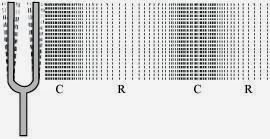
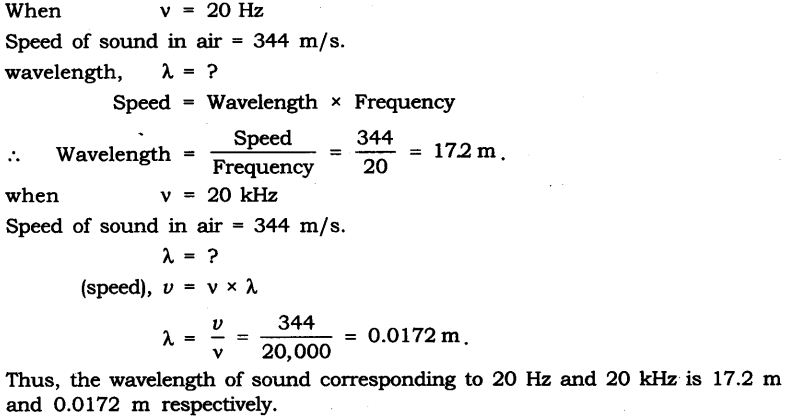






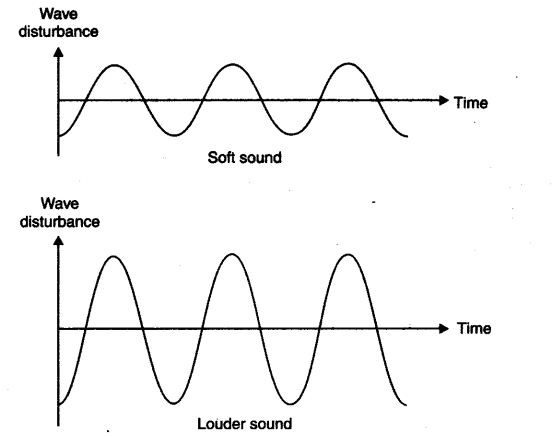
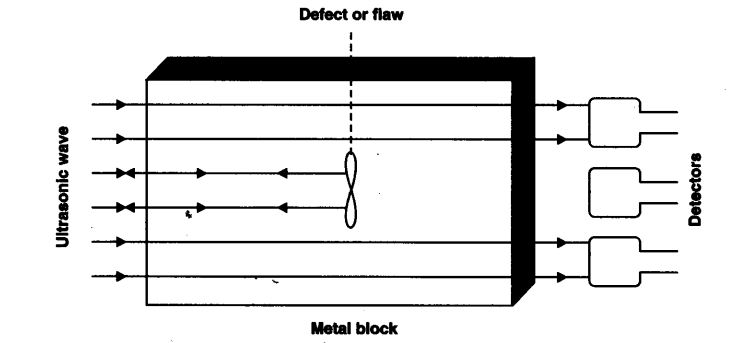

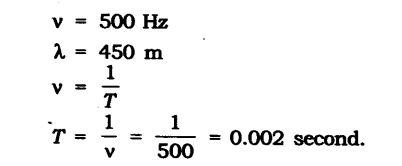
Leave a Reply